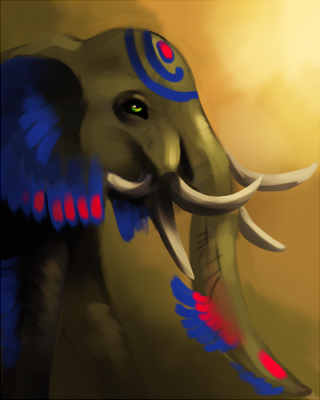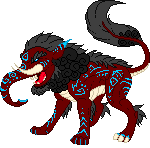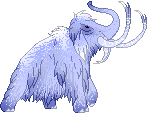The Airavatian Elephant

General Information;
The Airavatian Elephant, better known as the airavatians (or singularly an airavati), is a diverse species of proboscideans commonly noted for their large size, ivory tusks, and long, prehensile trunks. They are powerful guardians of nature, and can be commonly found in forests and jungles, living in small herds.
Statistics;
Name:: Airavatian Elephant; airavatians; airavati
Average Lifespan:: 500 years
Average Height:: 10ft/3m at the shoulder.
Average Weight:: N/A; varies on individual.
Location Found:: primarily the jungles and forests of Lizzarkyth and Xaeri.
*all statistics based on averages; extremes in any direction, or found in odd locations, are always allowed.
Notes;
Journey The Journey is something that many young Airavatian Elephants partake in; in groups of twos and threes, they will leave the herd to find a new place to thrive in and protect, create herds of their own. This is not only to help keep airavatian herds small, but also to spread their influence and guardianship where it may not be. Though airavatians are not often found in other Realms, very rarely may the Journey spread beyond Xaeri and Lizzarkyth, where their protection is needed the most.
Matriarchs All airavatian herds are led by a single female called the matriarch; she is the oldest and wisest of the herd, often mother and grandmother to several in the group. All bow to the matriarch, and will protect her with their lives. She is in charge of where the herd travels to, overseeing the Journey, and various other important matters.
Non-Ivory Tusks Most airavatian tusks and spikes are made of ivory. However, some are born that posses tusks of another material - sometimes bone, keratin, even less biological substances such as rock, metal, and wood. Though these are rare when they occur naturally - and are often tied to an airavati's elemental affinity, should they posses one - many who lose their tusks in battle or otherwise will have substitutes crafted, fitted, and enchanted to grow with them as they age.
Species Name Airavatians are very particular about how history views their species' name; bards and scholars have noted that while the true, full name should always be capitalized in writing - as Airavatian Elephant - when referred to normally, it should be lowercase. Thus, the terms airavatians and its singular variant airavati are permissible, and approved by those overseeing what such writers record.
Diet This is what this species, and any variants, may eat at any given time.
Common:
large leaves, grass, fruits
Uncommon:
twigs, shrubs, lichen.
Rare:
bark, roots.
Overview:
Airavatians are large herbivores who tend to eat whatever happens to be available to them, though they prefer grass or fruits. Whatever they eat, they consume in enormous quantities.
Both subspecies differ quite a bit from their parent species. Baku have been twisted by demon experiments into creatures far different from the airavatians they once were They devour nightmares instead of plantlife, and can make do with normal dream energy if necessary. The Inumuith tend to survive off of a diet of tundra shrubs, coarse grasses, moss, and whatever other plantlife they can find.
Credits;
Species info credited to Verridith, JPG, Fyfergrund, and Bucketorandomness.
In-Depth Information;
Appearance Airavatians are a species of large mammal most similar to elephants and other proboscideans. They are large herbivores with prehensile trunks and tusks often made of stunning ivory. However, that is where most similarities end; any airavati may exhibit an assortment of colors and patterns not seen in natural elephants, and may display various other mutations not limited to scales, spikes, horns, feathers, wings (usually vestigial) and many more. Eye color is often bright and multi-hued, and may glow uncommonly with their own inner light.
Airavatians vary greatly in build; most are the typical tubby behemoths, while others are more lithe and strangely thin. Their ears are generally quite large, but may be hidden behind other features or be very small in size. Tusks are also widely varied, and may be found in both males and females - though males tend to have the largest, most complex tusks while females' are simpler and smaller. Tusks vary from individual to individual, and come in a great diversity of style; some are straight while others may be branching and angular, while still others curve wildly into intricate, bony knots.
Culture Airavatian Elephants are a naturally nomadic race, living in small herds so as not to harm the forest overmuch in their passing. Each herd is lead by the oldest female, known as the matriarch, who is considered both strongest and wisest of the herd. This female guides the herd in the ways of protecting the balance, teaching young how to spot dangerous places or unnatural damage, and a variety of other things. Most herds live in Xaerin and Lizzarkythian forests and jungles, acting as the balance between herbivores and carnivores. They hold great respect among both carnivores and herbivores, and few dare challenge them beneath the leafy boughs of the lands under their protection. With the help of an airavati and its herd, herbivores do not consume more than the land can provide, and carnivores do not grow beyond the limits of available food. Each protected area is welcoming to visitors so long as they don't unbalance the whole; the methods of dealing with such imbalances are as varied as the herds. To keep these herds small, the matriarch oversees something called the Journey - a splitting of some younger members to go form small herds of their own, and gather new areas in which to protect.
Airavatians are incredibly intelligent, and are possessed of an ability to read most written languages without being taught; thus, their small herds are commonly sought out by bards, scholars, and historians to glean what such elephants have learned or to consult them in deciphering ancient script or similar objects. They keep strong oral histories, and never forget anything they have been told or have read. Most airavatians also greatly enjoy listening to music, legends, and stories by those not of their race.
An airavati has a peculiar view on life and death; both are celebratory things, for different reasons. Airavatian Elephants do not breed or beget offspring often, and thus the birth of a new child is a cause for great joy and happiness within any herd. Death, too, is seen as joyous; the spirit flees into eternal rest, and the body returns to nourish the earth with its flesh. An airavati near death will instruct its fellows on where he or she wishes to be buried, and often - unique to this race - what will be done with its tusks.
Airavatian ivory is greatly sought after by smiths and craftsmen of multiple races for its beauty and versatility, and a willing airavati may give up their tusks to be traded after their death for the betterment of the herd. However, ivory is also poached by bold hunters seeking profit. These hunters are often tracked down and killed by not only the offended herd, but by any other herds that may hear of it - and an airavatian never forgets the face or description of one who has killed its fellow elephant.
Abilities As defenders of nature, it is natural for airavatians to posses defense-based magic and abilities; many have healing, barrier magic, and the ability to sense and foresee danger. They also regularly possess nature-based elemental affinities to shape their surroundings without killing the flora already present, and to heal damaged areas in need of regrowth.
However, as an airavati grows older, this kind of helping magic may become uncontrollable, causing the oldest of airavatians to leave freshly growing plant life in their wake. This only becomes problematic when an elder is afflicted with a form of dementia known to the airavatians as 'dusk-mind decay'. Even though they possess a powerful photographic memory, an airavati that has used too much magic to keep an ecosystem stable for many centuries may begin to find their mind failing them. It starts as simple forgetfulness and grows more dire until the elder is in a vegetative state, and they let themselves become overgrown with flora. Sometimes, an older airavati may become injured or otherwise rendered unable to move, and may suffer a similar fate. These individuals are cared for by the rest of the herd as much as possible, and are honored for giving back to the world when they die.
Species Origin;

In an age long ago, there is said to have been a series of immense fires that threatened to consume a great number of Xaeri and Lizzarkyth's greenery. Each took many, many lives and even more of the lushness that Xaeri and Lizzarkyth was known for.
With the exception of one such place; a jungle in Lizzarkyth, where the fires had been turned aside. In this particular jungle, there was an unusually intelligent race of animals: elephants.
These elephants were able to irrigate water from lakes and ponds to fight the fires, and often worked in tandem with the other creatures of their home to help. In addition, they carried with them the knowledge of the events of past fires - thus having the capability of learning how to adapt to fight each blaze. However, even their efforts were not enough - for while they could fight the fires, the damage that was done was immense, and not even the intelligent elephant could heal the wounds of the land nor fight the infernos where their influence did not hold.
It was then that Rhator and Aelia took notice of this trend and came up with a plan to not only protect their Realms, but also restore them. They gave the gift of true sapience to the already-intelligent creatures, allowing them the ability to speak and see the world as others do. To these heroic elephants, they bestowed the power to restore and protect the forest, wherever they went - gifting them with the ability to regrow the land even when it had suffered great damage.
Among these was an elephant named Aravanti, who roamed the Realms far and wide coordinating efforts in fighting the great blazes and restoring the earth she so loved. Her passion touched many and inspired more to dedicate their lives to saving the Realm in which they dwelt. Aravanti's patience was limitless, and her compassion knew no end. And eventually, she was successful - the blazes were brought low and the green reclaimed the lands.
However, the burden was too much for her mortal vessel - and she fell ill. It is said that in the weeks she suffered under this illness, the forests and jungles lit up with cries of sorrow and despair. Yet, as the green consumed her body,as vines crawled over her hide and flowers blossomed around her trunk, as roots twisted and wove around her legs... she smiled. It was a sad smile - as if leaving one home to return to another. When she died, a small sapling took root as her soul fled, and those who knew her lifted their trunks to the sky in honor. The elephants that shared her power christened themselves the airavatians in her honor.
It is rumored that her corpse became a mighty tree that can still be found in Lizzarkyth today.
This species did not have an Ancient First.
Subspecies

Baku
Classification: Kuraian, nightmare-eating elephant. Location: Kurai.
Many centuries ago, there was a new herd of airavatians who found themselves trapped in the land of demons after a wayward Journey. There, they found twisted forests and wildlife that seemed to be radically out of balance; Kurai was damaged, sick to their eyes, and they wanted nothing more than to fix it. Calling more to them, the herd grew and then carefully started to work. However, these airavatians began to starve, for the plantlife could not safely be eaten and that which they seeded and grew died without thriving. On the verge of starvation, the gathered airavatians were found by a clan of Death demons, who saw opportunity and glory instead of living, breathing creatures. Thus, the airavations were taken captive, and were subjected to many magical experiments upon them. However, they survived - and their progeny persists today... but not as they were.
The elephants were airavatians no more; instead, they were termed 'baku' by their captors, and kept this name long after their escape. Smaller than true airavatians, baku have thick, curly manes of fur with longer tufts down their back and on their long tails. They have short, sharp tusks and mouths full of ripping fangs, though retain their trunks. Their ears are smaller, sharper, and sometimes tufted; similar tufts may be found on their chins (much like beards), elbows, ankles, and hocks. Their forequarters end in tiger-like clawed paws, and plates of study ivory cover their underbellies. Often, a baku will possess more dramatic spikes, multiple sets of tusks, multiple trunks, and other demonic appearances. Their colors are often darker than their parent species, though - much like others that have evolved in Kurai - their eyes and markings reflect the Kingdom they dwell in. Red for Death, green for Famine, gold for Pestilence, and blue for War.
However, despite their terrifying appearance, baku retain in great part the protective nature of the Airavatian Elephant. The demonic mages that changed them took away their need for physical sustenance; instead of plants, the baku feast on the bad dreams sapient creatures may have, although a good dream will also provide a meal if no nightmares are available. Rather than becoming a weapon to be used by the Death Kingdom, and being considered a failure because of their inability to weaponize the dreams they eat, they have turned to putting such an ability to use elsewhere. Living in small groups no more than three or four, a family of baku may take of residence near other races, most commonly demons in their Kingdom of birth, so that the baku may devour their nightmares of those that dwell within. Demon villages have grown rather fond of these creatures and regularly make small versions for their children to sleep with, though humans are more protective of their dreams.

Inumuith
Classification: tundra airavatians. Location: the iciest northern regions of most Realms.
Large, bulky versions of their warmer cousins, these airavatians are covered in immense coats of thick fur and live in the colder climates available. They are taller and have generally larger tusks, more brilliant eyes, and are commonly light in color. Most know these creatures as 'inumuiths' or 'inu mammoths', though the origin of the name is currently unknown.
Instead of nature magic, inumuiths are able to use ice magic and usually protect the delicate balance of life and those that threaten it in the tundra regions of the Realms. They are more prone to violence than others, and will defend their land with more vigor, than their forest-bred cousins.
